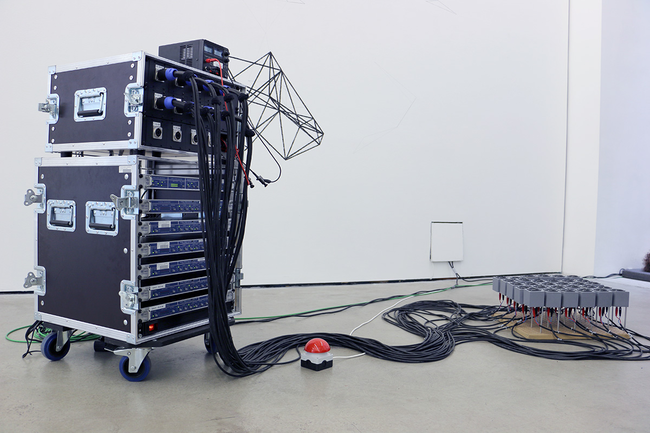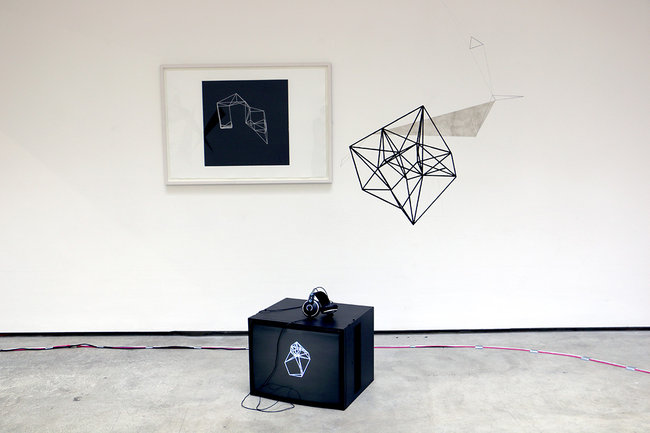DA TA rush
Transpositon not Exhibition
A research event by Gerhard Eckel, Michael Schwab, David Pirrò, and Artemi-Maria Gioti. Angewandte Innovation Laboratory, Vienna/Austria, May 13-17 2016.
DA TA rush was a transposition, not an exhibition. It engaged with artificial neural networks, brain activity, architectural mapping, motion capture, galaxy cluster surveys and modelling, particle physics, dynamical systems simulations, room impulse response measurements, air flow turbulences, and sonic textures.
The transposition investigated emergent formal and perceptual relationships between data events distributed across the gallery, which can be viewed in the video above. A set of triggers excited a dynamic system, which articulated and integrated what was performed in DA TA rush.
DA TA rush asked if it is possible to liberate data from its representational duties. It enacted data as an imaginary, lived body between the various material elements, human bodies included. How does data pass from one form to another? Are there artistic forms capable of associating what seems highly diverse?
A set of triggers are distributed in the DA TA Rush exhibition. Some are very visible red trigger buttons, others are part of the individual installations — for example the keys of the piano or the headphone jacks of a sound work — and others are more subtle, such as a microphone hung from the ceiling. When the triggers are activated, they excite the installation that they are part of, for instance pressing a piano key may trigger the piano to play.
However, the effect of this action is not limited to this local effect. The simulation of a dynamical system is part of the exhibition. This system is composed of seven interacting masses resembling a very simple mechanical approximation of a string. Depending on the energy of all these oscillations and resonances, one node in the string is pushed and pulled.
There is a correspondence between a node in the system and its energy and one of the works in the exhibition and its activity. Pressing a trigger will give a push to the associated mass, exciting it and inducing an energy growth which, in turn, is reflected by the installation's action or reaction.
A trigger, an action on the installations or a loud vibration in the gallery, will not only excite one of the masses, it will also inject energy into the whole system. As all elements are interconnected by their reciprocal interactions, energy will propagate through the nodes, and therefore through the exhibition space. Each action will spread and leave a trace, possibly causing other installations to react at a later time.
Through this reciprocal interaction, metaphorical and actual connections are drawn between the works, the gallery space and the external world. The whole exhibition reveals itself as a system which senses and unfolds, continuously re-weaving and regenerating itself. The evolving state of the dynamical system, i.e. the energy in each of its nodes, is transposed into a visual effect — the intermittent glowing of hanging light bulbs in a dark room in the basement of the gallery, in the "belly" of the exhibition.
The ground floor walls (121.3m) are interpreted as canvas for two continuous timelines (shown in red in the floor plan.) Timeline 1, which starts at the front right of the gallery and continues anti-clockwise, consists of the frames of the lanser video from case study 1 (from beginning to end.) Timeline 2, which starts at the front left of the gallery progressing clockwise, consists of drawings of galaxy cluster data from case study 3 (from today back in time to the big bang.) Drawings were chosen inuitively from both sets of data to suit the space; however, a selected drawing would always be on its predetermined position on its timeline.
Views into the gallery show a spatial representation of time, i.e. a move back in cosmological history or through the activations of the artificial neural network, allowing us to compare points in time in one view.
The last galaxy cluster (the wire frame 'pyramid' on the image on the left) is actually quite far away from the big bang (or the entrance to the gallery), since before it, galaxy clusters were much rarer not leaving a trace in the drawing algorithm.
The relational dynamics of the time-based exhibits of the exhibition, which is experienced as a fluctuating field of sound, is matched to the visual dimension by various objects that merge into the fabric of the exhibition, the architecture as well as — through the windows — the gallery's urban context.
This video was recorded with a head mounted camera and microphones placed at the entrance of the ear canals to create a binaural sound track. Use headphones for increased immersion.
The DA TA rush symposium took place on May 17, 2016. Here is an audio recording of one of the sessions.
Angewandte Innovation Laboratory↗
Case Study II - Deep Inelastic Scattering
Case Study III - Cosmology
Event 5: Transpositions Lab. Exploring DA TA rush with interventions by Paulo de Assis and Lucia D'Errico leasing to Rasch15-22↗. Angewandte Innovation Laboratory, Vienna/Austria, May 14-16 2016.
Event 6: Symposium. Is a meaningful dialogue possible between research practices in the arts and in science and technology?↗ A one day symposium organised by philosopher Cecile Malaspina. Angewandte Innovation Laboratory, Vienna/Austria, May 17 2016.










